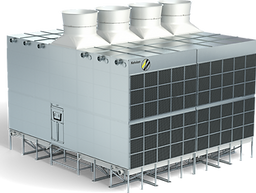
Episode 3
CAPTURE TOWER
TECHNOLOGIES
Direct Air Capture (DAC) is a technology being used to remove carbon dioxide (CO₂) directly from the atmosphere. It uses processes that actively bind with CO₂ from the air. Once captured, the CO₂ can either be stored underground or utilized in products like synthetic fuels, carbonated beverages, or building materials.
The purpose of DAC is to reduce global warming by neutralizing CO₂ emissions from hard-to-decarbonize industries, e.g. aviation and by realizing carbon-negative by permanently sequestering CO₂.
However, DAC systems are energy-intensive, requiring precise temperature control to optimise performance and minimise energy consumption. That’s where our expertise comes in. Our industrial heat exchangers and capture towers are designed to meet the unique thermal challenges of DAC, providing efficient heat or mass transfer, temperature regulation, and energy recovery. Whether it’s cooling systems, air-liquid exchangers, or regenerative heat exchangers, we offer tailor-made solutions that enhance the efficiency and sustainability of DAC processes.

GENERAL PROCESS

High temperature Liquid Sorbent Based Systems (L-DAC)
L-DAC systems use chemicals like potassium hydroxide to absorb CO₂
S-DAC systems use porous solid materials, so called adsorbents to capture the CO₂
Low-temperature Solid Sorbent Based Systems (S-DAC)
There are two main technologies being used for DAC:
ABSORPTION
DESORPTION
HYDROLYZER
Filtered Air
Permanent
CO₂ storage
CO₂ - loaded sorbent
Liquid-sorbent Based DAC Process Scheme
Ambient Air
CO₂ - gas
> 99,99% purity
CO₂
Desorption
Basified sorbent
Acidified electrolyte
Electrolyte for acid/base regeneration
Hydrolyzer for acid/base regeneration
Air contactor
The DAC process consists of mainly 3 steps:
Ambient Air
CAPTURE TOWERS
FOR DIRECT AIR CARBON CAPTURE
By adapting proven thermal and flow dynamics from the cooling tower world, capture towers offer a reliable, energy-efficient solution for DAC applications. Their modular, flexible, and scalable architecture enables easy deployment across various climates, landscapes, and air capture targets.
Capture tower single unit design approach

CAPTURE TOWERS
DIFFERENT WORKING PRINCIPLES
Counterflow Capture Towers
In counterflow designs, air moves vertically upward while liquid sorbent is sprayed downward from the top.
-
The air and liquid flow in opposite directions, creating extended contact time and efficient CO₂ absorption.
-
Liquid is atomized or sprayed via pressurized nozzles, forming fine droplets over packing material.
-
The tower structure contains structured packing to facilitate mass transfer.
-
Air enters from the base and exits through the top, passing through drift eliminators.
-
Better vertical distribution of capture solution for consistent operation.
Crossflow Capture Towers
In a crossflow configuration, ambient air moves horizontally through the tower while the liquid sorbent flows vertically downward.
-
The liquid is distributed from the top and passes through structured or random packing media.
-
As the air flows perpendicular to the falling liquid, CO₂ is absorbed by the capture solution.
-
Easier maintenance due to open-top liquid channels.
-
Lower energy consumption for air movement (natural or assisted draft).

CAPTURE TOWERS
MODULARITY, FLEXIBILITY & SCALABILITY
One of the key strengths of this design philosophy is its inherent modularity:
-
Stackable Design:
Capture tower modules can be stacked vertically to increase air-solvent contact time, improving CO₂ absorption performance.
-
Flexible Fill Selection:
Towers can incorporate various fill types (structured or random, like heat exchanger applications), optimized for pressure drop, droplet size, and absorption kinetics.
-
Scalable Configurations:
Systems can be designed as multiple small units in parallel (for distributed air flows) or as a single large unit
(for centralized, high-volume processing)—tailored to site constraints and performance requirements.
-
Expandable Footprint:
Systems can be easily expanded in stages as demand grows or capture targets increase.




FOCAL-POINT: CAPTURE TOWERS TECHNOLOGIES - USING DECADES-LONG EXPERIENCE DIFFERENTLY
Capture Towers are the crucial front-end equipment for DAC process plants and must be properly designed to ensure an efficient and reliable DAC process.
In this paper we will delve into the technology of liquid-based DAC, further explain our capture tower technology and showcasing a real-life example – the combined expertise of Phlair and Kelvion.
READ MORE and DOWNLOAD OUR TECH-PAPER
OUR SOLUTIONS FOR CAPTURE TOWER TECHNOLOGIES

Air Capture Tower



